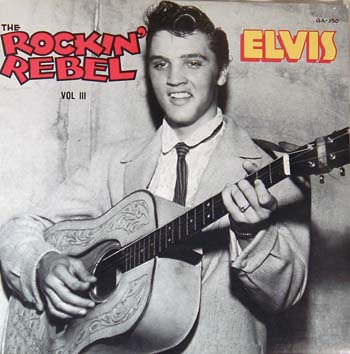

“ The Rockin’ Rebel vol. 3 ” on Golden Archives GA-350 was
released in 1979 and hails from the USA.
The cover of this final volume is not a gatefold cover, but has a
wonderful Sun era black and white photo possibly taken by Memphis photographer
Jim Reid ( thanks Claude ). This
photo, once again, follows the theme of the LP series thus far.
The back cover has a black and white still from Jailhouse Rock flanked on
the left by the track listing ( black text on a yellow background ) with
information on the individual tracks.
The LP label on this third volume is no different than the previous
two volumes; the standard treasure trunk overflowing with “archived discs”
with a red background on the top half, and light blue background with the track
listing in black text on the lower half. The
sources of the tracks are of excellent quality, and once again the LP is a
quality pressing with very little surface noise.
Side 1:
“ Loving You ” main version “ KX ” take 19 is prefaced with
15 seconds of dialogue that was taken from prior to take 20 and spliced in front
of the dialogue that precedes take 19. The
producers, however, edited out a snippet of the sound engineer who is calling
out the take numbers after Elvis says “Lets make one more then hear this last
one…naw naw”. The phrase “ KX
20 ” from the control room is edited out but is clearly heard on the second CD
of the two-CD FTD “Loving You” release which contains this complete session
from Feb 14, 1957.
“ Old Shep ” is the alternate take 5 (take 1 was the master)
which was released in error on some pressings of Elvis’ second LP “Elvis”
from 1956. It was officially
released as an alternate take on the 50’s Masters Boxset, but on this LP is
most likely taken from an original 33 1/3 LP source as released by accident.
“ Loving You ” ballad/farm version “ HZ ” from Feb 14, 1957
give us three false starts and a complete alternate take: Take 7 false start,
Take 8 long false start, Take 9 long false start, take 10 complete.
The producers edited all of these takes and removed the two hand claps
between the count off and acoustic guitar intro chords.
In the case of the takes 9 and 10, Elvis clears his throat during the
hand claps which remain intact on the FTD “ Loving You ” session CD.
The next three tracks are taken from Elvis’ July 1, 1956 Steve
Allen Show appearance. “ I Want
You, I Need You, I Love You ” was Elvis’ most recent single released in May
1956 to a pre-order of 300,000 ( the largest pre-order for RCA at the time ). “
Hound Dog ” was sung to a basset hound and Steve Allen makes mention that
Elvis is going to record the song the following day in the studio.
And lastly Elvis’ involvement singing four lines in a comedy sketch as
“ Tumbleweed Presley ” is included for some giggles.
Side 2:
“ Loving You ” main version “ KX ” take 6 was also recorded
during the Feb 14, 1957 session. The
producers of this LP edited out the four snare drum beats between the count off
and the start of the song, which plays in full on the FTD “ Loving You ”
session CD. Direct comparison
proves this to be take 6; Elvis’ phrasing is a perfect match, even down the
single wrong bass note (1:27 on the mono source, 1:25 on the binaural source) on
the session CD.
Elvis’ first Ed Sullivan appearance on Sept 28, 1956 was hosted by
Charles Laughton as Ed Sullivan was watching from a hospital room after being in
an automobile accident. The
introductory comments made by Charles are included on this album and Elvis
performs classic 50’s versions of “ Don’t Be Cruel ”, “ Love Me Tender
”, “ Ready Teddy ”, and “ Hound Dog ”.
Thankfully we have these TV performances as visual and audio
documentation of Elvis performing live in the 1950s.
Next up is an October 1956 March of Dimes interview.
The questions are not heard, only Elvis talking as if responding to
questions (though it sounds like he is just reading answers as if he is being
asked questions). The RCA studio
version of “ Love Me Tender ” is featured here.
Finally we wind up with an interview by Ed Ripley recorded in Daytona
Beach, Florida at the Peabody Auditorium. Ed
narrates an introduction, which provides insight into how the interview came
about as Col. Parker came to their local radio station to purchase advertising
time for the upcoming show and the Col. granted Ed permission for the interview.
During the interview, fans can be heard in the background and at one
point one fan breaks a glass window. This
LP is apparently the first source for this unique interview.
While Elvis’ early career is better represented by the first two
volumes of this LP series, there are certainly some great moments on this LP
that continue that theme. I think
the 1957 tracks are a little out of place as they are more polished and because
they are from a movie soundtrack, present Elvis in the more expanded roll of
film entertainer. These light
hearted films of course were to lead Elvis’ career into a slump in the 60’s.
However good these 50’s films may be, the direction his film career,
and hence his music career, took tend to take the glimmer off of his early film
work. His early films may have been
mediocre to good, but what didn’t happen is the big disappointment.
Ernie Boyes Jr.